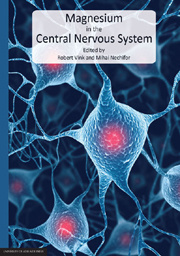Book contents
- Frontmatter
- List of Contributors
- Preface
- Contents
- Section 1 Magnesium in Normal Brain
- Section 2 Magnesium in Neurological Diseases
- Chapter 7 The role of magnesium therapy in learning and memory
- Chapter 8 The role of magnesium in headache and migraine
- Chapter 9 Magnesium in edema and blood-brain barrier disruption
- Chapter 10 Magnesium and hearing loss
- Chapter 11 The role of magnesium in pain
- Chapter 12 The role of magnesium in traumatic CNS injury
- Chapter 13 The use of magnesium in experimental cerebral ischaemia
- Chapter 14 Magnesium in subarachnoid hemorrhage
- Chapter 15 Magnesium in clinical stroke
- Chapter 16 Magnesium in cancer: more questions than answers
- Chapter 17 Magnesium in Parkinson's disease: an update in clinical and basic aspects
- Section 3 Involvement of Magnesium in Psychiatric Diseases
Chapter 15 - Magnesium in clinical stroke
from Section 2 - Magnesium in Neurological Diseases
Published online by Cambridge University Press: 05 June 2012
- Frontmatter
- List of Contributors
- Preface
- Contents
- Section 1 Magnesium in Normal Brain
- Section 2 Magnesium in Neurological Diseases
- Chapter 7 The role of magnesium therapy in learning and memory
- Chapter 8 The role of magnesium in headache and migraine
- Chapter 9 Magnesium in edema and blood-brain barrier disruption
- Chapter 10 Magnesium and hearing loss
- Chapter 11 The role of magnesium in pain
- Chapter 12 The role of magnesium in traumatic CNS injury
- Chapter 13 The use of magnesium in experimental cerebral ischaemia
- Chapter 14 Magnesium in subarachnoid hemorrhage
- Chapter 15 Magnesium in clinical stroke
- Chapter 16 Magnesium in cancer: more questions than answers
- Chapter 17 Magnesium in Parkinson's disease: an update in clinical and basic aspects
- Section 3 Involvement of Magnesium in Psychiatric Diseases
Summary
Abstract
Stroke is the second leading cause of death and a leading cause of disability worldwide. Unfortunately, current therapies for acute ischemic stroke are of extremely limited effectiveness. The ideal neuroprotective agent for stroke would be inexpensive, readily available, easy to administer and have no significant adverse side effects. Intravenous magnesium sulfate offers promise as just such an agent. In clinical trials to date, administration of magnesium sulfate has shown favorable trends toward neuroprotection in resuscitated cardiac arrest patients, in cardiac bypass surgery and carotid endarterectomy. In acute stroke, eight pilot clinical trials of magnesium sulfate have shown good safety, and the subset of pilot trials with randomized controls have shown favorable effects on clinical outcome point estimates. The first phase 3 trial of magnesium sulfate for focal stroke was the Intravenous Magnesium Efficacy in Stroke (IMAGES) Trial. Hampered by late administration of study agent, IMAGES overall produced a neutral result, but exploratory analyses identified early (under 3 hour), lacunar stroke, hemorrhagic stroke, and severely hypertensive patients as having a potential differential beneficial response to magnesium that deserved further investigation. The Field Administration of Stroke Therapy – Magnesium (FAST-MAG) trial has been specifically designed to test magnesium in the hyperacute time window by initiating therapy in the prehospital setting.
- Type
- Chapter
- Information
- Magnesium in the Central Nervous System , pp. 205 - 216Publisher: The University of Adelaide PressPrint publication year: 2011
- 7
- Cited by



